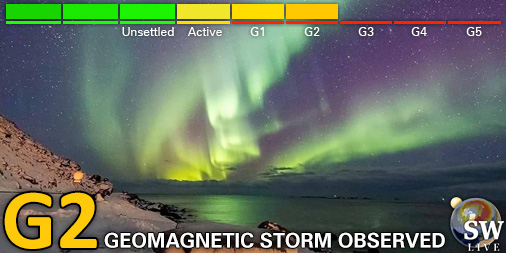Viewing archive of Saturday, 8 March 2003
Solar activity report
Any mentioned solar flare in this report has a scaling factor applied by the Space Weather Prediction Center (SWPC). Because of the SWPC scaling factor, solar flares are reported as 42% smaller than for the science quality data. The scaling factor has been removed from our archived solar flare data to reflect the true physical units.
Report of Solar-Geophysical Activity 2003 Mar 08 2200 UTCPrepared by the NOAA © SWPC and processed by SpaceWeatherLive.com
Joint USAF/NOAA Report of Solar and Geophysical Activity
SDF Number 067 Issued at 2200Z on 08 Mar 2003IA. Analysis of Solar Active Regions and Activity from 07-2100Z to 08-2100Z
Solar activity increased to low levels today. The
largest flare during the period was a C2.6/Sf event that occurred in
Region 206 (N05E63) at 08/0957Z. White light currently shows this
group to consist of a single large penumbral spot which may share
both polarities. Will be able to better analyze once region rotates
further onto disk. A C1.0 flare was observed from Region 301
(N22W18) at 08/0116Z. There was little in the way of magnetic
structure changes seen in this region during the period. Region 297
(S14W25) produced a couple low level B-class flares today. Regions
307 (S26W02) and 308 (n08E75) were newly assigned today.
IB. Solar Activity Forecast
Solar activity is expected to be at
low levels. There is a small chance for an isolated M-class flare
from Region 296 (N13W31).
IIA. Geophysical Activity Summary 07-2100Z to 08-2100Z
The geomagnetic field has been at quiet to unsettled levels. There
was an isolated active period at mid latitudes in response to a
southward oscillation in the Bz component of the interplanetary
magnetic field between 08/1500 and 1800Z. The coronal hole high
speed stream that has been geoeffective for the past several days
appears to have rotated out of its favorable position early in the
period. The greater than 2 MeV electron fluxes at geosynchronous
orbit reached high levels again today.
IIB. Geophysical Activity Forecast
The geomagnetic field is
expected to continue at quiet to unsettled levels throughout the
period.
III. Event Probabilities 09 Mar to 11 Mar
| Class M | 20% | 20% | 20% |
| Class X | 01% | 01% | 01% |
| Proton | 01% | 01% | 01% |
| PCAF | green | ||
IV. Penticton 10.7 cm Flux
Observed 08 Mar 148 Predicted 09 Mar-11 Mar 150/150/145 90 Day Mean 08 Mar 142
V. Geomagnetic A Indices
Observed Afr/Ap 07 Mar 013/014 Estimated Afr/Ap 08 Mar 008/009 Predicted Afr/Ap 09 Mar-11 Mar 008/010-007/010-007/008
VI. Geomagnetic Activity Probabilities 09 Mar to 11 Mar
| A. Middle Latitudes | |||
|---|---|---|---|
| Active | 20% | 15% | 15% |
| Minor storm | 01% | 01% | 01% |
| Major-severe storm | 01% | 01% | 01% |
| B. High Latitudes | |||
|---|---|---|---|
| Active | 25% | 25% | 20% |
| Minor storm | 10% | 10% | 05% |
| Major-severe storm | 01% | 01% | 01% |
All times in UTC
Current data suggests there is a slight possibility for aurora to appear at the following high latitude regions in the near future
ReykjavikTromsø
Latest news
Latest forum messages
Large Coronal Hole 25 120Aurora photography hints for those of us with smartphones 43Photographing auroras 34AR4043 8More on an art than a science 3
More topicsSupport SpaceWeatherLive.com!
A lot of people come to SpaceWeatherLive to follow the Sun's activity or if there is aurora to be seen, but with more traffic comes higher server costs. Consider a donation if you enjoy SpaceWeatherLive so we can keep the website online!

Latest alerts
20:30 UTC - Geomagnetic activity
Moderate G2 geomagnetic storm (Kp6) Threshold Reached: 20:08 UTC
20:15 UTC - Geomagnetic activity
Minor G1 geomagnetic storm (Kp5) Threshold Reached: 20:00 UTC
18:00 UTC - Geomagnetic activity
Moderate G2 geomagnetic storm (Kp6) Threshold Reached: 17:00 UTC
17:00 UTC - Geomagnetic activity
Minor G1 geomagnetic storm (Kp5) Threshold Reached: 16:28 UTC
14:15 UTC - Geomagnetic activity
Moderate G2 geomagnetic storm (Kp6) Threshold Reached: 13:58 UTC
Space weather facts
| Last X-flare | 2025/02/23 | X2.0 |
| Last M-flare | 2025/03/26 | M1.0 |
| Last geomagnetic storm | 2025/03/22 | Kp6- (G2) |
| Spotless days | |
|---|---|
| Last spotless day | 2022/06/08 |
| Monthly mean Sunspot Number | |
|---|---|
| February 2025 | 154.6 +17.6 |
| March 2025 | 135 -19.6 |
| Last 30 days | 133.7 -19.9 |







